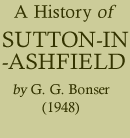< Previous | Contents | Next >
Chapter XV.
Locomotion
The means of communication were such as were common to all country villages and Carriers Carts were common. In 1832 Thomas Wilson from Low Street, and Thomas Bullock from Back Lane (now High Pavement) ran on Wednesdays and Saturdays to Nottingham and Denis Whetton carried the daily Mail to Mansfield. In 1838 J. Jephson ran the ' Sherwood Forester ' Van from the Swan Inn, and Sam Bailey from the Bull Inn in King Street, and Thomas Wilson from the Brick & Tile Yard to Nottingham and a Gig to carry the Mail ran daily to Nottingham. The Post Office was in the house at the top of Market Street once occupied by J. W. Valantine, the Surgeon.
In 1844 Sam. Bailey from New Road ran to Nottingham on Monday and Wednesday and Daniel Fletcher from Low Street and Thomas Wilson to Nottingham and James Whetton from Low Street to Mansfield daily. J. Weston ran a Cart to Alfreton and Derby every Friday, and Messrs. Kemp & Smith from the Blue Bell Inn on Thursday.
In 1853 Michael Heathcote ran every Wednesday, Friday and Saturday to Nottingham from Low Street, where he at that time had a farm yard on the site now occupied by the Westminster Bank.
Later William Wilson from the Brick & Tile Yard ran the same days to Nottingham with a Van on which was painted " Better late than never," an allusion to some failure on Heathcote's part. On which Heathcote had his Van marked " Better, never late," and the services were known by these names.
The introduction of Railways was preceded by a Tramway made under an Act of Parliament of 1817 which ran from Bulls Head Lane, Mansfield to a Wharf at Pinxton on the Pinxton and Cromford Canal, and which was seven and a half miles long. The cars were hauled by horses to the summit at East Kirkby and then ran by their own volition down the inclines to both termini. The wheels ran on flat plates laid on the track which had flanges on their inner edge to prevent the wheels running off and were the invention of James Outram. But these plates were never laid and remained at Pinxton for years as Mr. Jessop who had introduced the edge railway, with flanged wheels in 1768 refused to join the scheme. However, a new Company was formed and Outram plates laid in 1817. It was from this invention that Outram (later reduced to Tram) ways derived their name. It was opened for traffic in 1819 and ran through Sutton parish from Kirkby Hardwick to the head of the Reservoir. It was purchased by the newly formed Midland Railway in 1847 for £21,066. The Railway from Nottingham was opened to Kirkby for passengers on 2 October, 1848, and on to Mansfield 9 October, 1849, a station being opened on the Forest Road with William Clay as Stationmaster and Jos. Allen as Signal-man and Porter. On 1 May, 1892 a branch line was opened up to the town, at a cost of £52,448.
The Great Northern Railway Company opened an extension of their line from Nottingham to Newstead, to Sutton and Langwith with a station in Outram Street, on 4 April, 1908, and it was closed to passengers in 1931, no effort having ever been made to make this most convenient line popular.
The Street Tramway from Mansfield to Huthwaite running through Sutton was commenced 1 September, 1904, and this, owing to the superior convenience of Motor Omnibuses, was discarded by the Tramway Company in 1932, their Motor Omnibuses commencing to run on Sunday, 18 September of that year.
